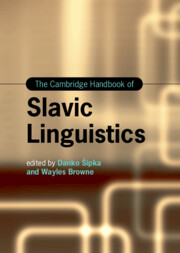Book contents
- The Cambridge Handbook of Slavic Linguistics
- Cambridge Handbooks in Language and Linguistics
- The Cambridge Handbook of Slavic Linguistics
- Copyright page
- Contents
- Figures
- Tables
- Contributors
- Introduction
- Part 1 Prosody and Phonology
- 1 Word Stress
- 2 Vocalism: The Vowels
- 3 Consonantism: The Consonants
- 4 Syllable Structure
- 5 Phonologically Conditioned Alternations
- 6 Prosodic Reflexes of Information Structure
- Part 2 Inflectional and Derivational Morphology
- Part 3 Syntax
- Part 4 Lexicon
- Part 5 Sociolinguistic and Geographical Approaches
- Part 6 Experimental and Quantitative Approaches
- Name Index
- Subject Index
- References
5 - Phonologically Conditioned Alternations
from Part 1 - Prosody and Phonology
Published online by Cambridge University Press: 16 May 2024
- The Cambridge Handbook of Slavic Linguistics
- Cambridge Handbooks in Language and Linguistics
- The Cambridge Handbook of Slavic Linguistics
- Copyright page
- Contents
- Figures
- Tables
- Contributors
- Introduction
- Part 1 Prosody and Phonology
- 1 Word Stress
- 2 Vocalism: The Vowels
- 3 Consonantism: The Consonants
- 4 Syllable Structure
- 5 Phonologically Conditioned Alternations
- 6 Prosodic Reflexes of Information Structure
- Part 2 Inflectional and Derivational Morphology
- Part 3 Syntax
- Part 4 Lexicon
- Part 5 Sociolinguistic and Geographical Approaches
- Part 6 Experimental and Quantitative Approaches
- Name Index
- Subject Index
- References
Summary
This chapter provides an overview of phonologically conditioned synchronic alternations representative of Slavic languages. The vocalic processes covered are vowel reduction and resulting phonological neutralization patterns in unstressed syllables, vowel-zero alternations, alternations in vowel quantity due to compensatory lengthening or to rhythmic requirements, and alternations in vowel quality, such as fronting/backing and raising/lowering. The consonantal processes discussed include alternations in voicing, such as voicing assimilation and word-final devoicing, and palatalization before front vowels and as a result of assimilation in a consonant cluster. Some language-specific alternations are also discussed.
Keywords
- Type
- Chapter
- Information
- The Cambridge Handbook of Slavic Linguistics , pp. 87 - 103Publisher: Cambridge University PressPrint publication year: 2024



